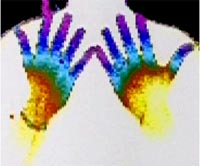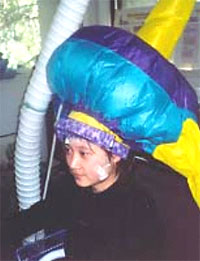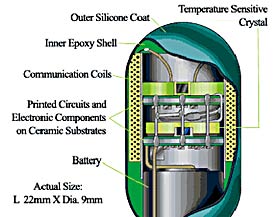UC Berkeley Press Release
UC Berkeley researcher wins award for work on human thermal comfort model
BERKELEY – University of California, Berkeley, researcher Zhang Hui has helped develop a sophisticated mathematical model to predict human thermal comfort that can be used to design energy-efficient temperature systems that make people more comfortable in vehicles, buildings and outdoor spaces.
 Infrared photos recorded physiological responses. When subjects were cool, photos reflected large skin temperature variations. (Photos courtesy of the Building Sciences Group in UC Berkeley’s College of Environmental Design) |
At UC Berkeley's Building Sciences Group in the College of Environmental Design, her work has contributed to a sophisticated model based on measurements of skin and body core temperatures and their rates of changes. That information is correlated with the subjective sensation and comfort assessments of 27 people in changing, neutral, cold, and warm environments in an office setting. Additional experiments were conducted in an automobile inside a hot - then cold - wind tunnel, validating the model results from Hui's workplace study.
In recognition of the model, Hui recently received an international award issued annually for contributions to human comfort studies. She accepted the Ralph G. Nevins Physiology and Human Environment Award on June 26 during a conference of the American Society of Heating, Refrigerating and Air-Conditioning Engineers in Nashville, Tenn.
Hui's model provides "an important missing link between human physiological response to the thermal environment and our subjective experience," said Charlie Huizenga, a research specialist in the Building Sciences Group. Along with UC Berkeley Professor Ed Arens, he supervised Hui's doctoral dissertation study, which was published last year and formed the basis for the model.
In the past, Huizenga said, researchers and engineers were able only to predict subjective sensation to uniform, stable thermal conditions - something found only in a research laboratory.
"Consider driving a car as the sun falls on your shoulder and the air conditioner blows cold air on your arms and lap. Or sitting in the sun with a cool breeze blowing through an open window," Huizenga said.
"Hui developed models that enable us to evaluate such environments and predict the human subjective experience. This was a formidable task, and her work will have considerable value to designers of buildings, automobiles or even outdoor parks. By improving our understanding of thermal comfort under realistic conditions, designers will be able to create environments both more pleasant and more energy efficient."
Engineers, architects and experts in heating, air conditioning and ventilation can use the model to design thermally comfortable spaces, rather than some of the all-too-common structures that have occupants freezing one minute and sweltering the next.
"That is the goal, and we are going steadily toward it," said Hui, who is now working to apply the model to such things as the fašade and perimeter of a building.
The model can gauge temperatures of the head, face, neck, breathing zone, chest, back, pelvis, left and right upper arms, left and right hands, left and right thighs, left and right lower legs, and left and right feet. An on-screen human body can then indicate in various colors the different body temperature changes brought on by varying thermal air conditions. The model also presents temperature charts for each part of the body for those conditions.
"There is a Chinese saying: If the chest and back are warm, the whole body is warm," Hui wrote in her thesis. "Those areas hold the high priority in keeping the whole body thermally comfortable. Certain body parts have much less influence on the overall body sensation than others."
 Test subjects were outfitted with a head-cooling air sleeve that resembles an old-fashioned hair dryer. |
Exerting the most influence on overall sensation, Hui said, are the chest, back and pelvis. Next are the head, face, neck, breathing zone, upper and lower arms, and thigh and lower leg. Of least influence: the hand and foot.
"Just as the primary functions of hand and foot are different, the three groups of the body parts serve their own thermal purposes," she wrote in her thesis.
She used primarily students in her tests in an environmental chamber on campus from January 2002 through mid-August 2002. They ranged in age from 20 to 50, and included 12 males and 15 females. Before tests began, subjects spent 15 minutes in a Jacuzzi bathtub, with a 250-watt lamp overhead, to precondition their whole-body temperatures. During tests ranging from two to three hours, environmental chamber temperatures were controlled to set ranges from 20 to 30 degrees Celsius. Subjects dressed in leotards and socks performed work on a computer. Specially fabricated air sleeves made of spinnaker cloth on the outside and mesh fabric on the inside were used to cool and heat individual areas of their bodies.
  Human subjects participating in Hui’s thermal
comfort research swallowed a small pill, diagrammed above, which transmitted
data about their core temperatures to a small receiver nearby.
Human subjects participating in Hui’s thermal
comfort research swallowed a small pill, diagrammed above, which transmitted
data about their core temperatures to a small receiver nearby. |
Their skin temperatures were measured at 28 locations on various body parts by thermocouples wired to relay the information to a computer database. The subjects' core temperatures were taken with the aid of a wireless sensor in the form of a pill. A recorder wrapped around a subject's waist recorded, displayed and stored temperature information every 20 seconds, and later was sent to a computer to be analyzed.
Hui's research was funded by the National Renewable Energy Laboratory, Delphi, UC Berkeley's Center for Information Technology Research in the Interest of Society (CITRIS), and the National Science Foundation.
Follow-up tests were conducted in a wind tunnel at Delphi-Harrison Thermal Systems in Lockport, N.Y., where subjects controlled their car air temperature settings.
The Building Science Group conducts research and teaches about building process topics relating to energy efficiency and the environmental quality of buildings.

